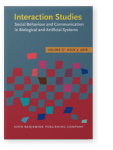Fukawa, Nobuyuki, Yu‐Shan (Sandy) Huang & Barry J. Babin
2024.
Pepper, just show me the way! How robotic shopping assistants should look and act.
Journal of Consumer Behaviour 23:3
► pp. 1329 ff.

Yang, Maosheng, Juan Li, Lei Feng, Shih-Chih Chen & Ming-Lang Tseng
2024.
Service robot anthropomorphism on consumer usage intention: curvilinear and linear effect.
Industrial Management & Data Systems 124:2
► pp. 612 ff.

Diana, Fabiola, Misako Kawahara, Isabella Saccardi, Ruud Hortensius, Akihiro Tanaka & Mariska E. Kret
2023.
A Cross-Cultural Comparison on Implicit and Explicit Attitudes Towards Artificial Agents.
International Journal of Social Robotics 15:8
► pp. 1439 ff.

Shen, Junyi, Guyue Tang & Shinichi Koyama
2023.
Robot occupations affect the categorization border between human and robot faces.
Scientific Reports 13:1

Blaurock, Marah, Martina Čaić, Mehmet Okan & Alexander P. Henkel
2022.
Robotic role theory: an integrative review of human–robot service interaction to advance role theory in the age of social robots.
Journal of Service Management 33:6
► pp. 27 ff.

Gemeinboeck, Petra & Rob Saunders
2022.
Moving beyond the mirror: relational and performative meaning making in human–robot communication.
AI & SOCIETY 37:2
► pp. 549 ff.

Jørgensen, Jonas, Kirsten Borup Bojesen & Elizabeth Jochum
2022.
Is a Soft Robot More “Natural”? Exploring the Perception of Soft Robotics in Human–Robot Interaction.
International Journal of Social Robotics 14:1
► pp. 95 ff.

Schreibelmayr, Simon & Martina Mara
2022.
Robot Voices in Daily Life: Vocal Human-Likeness and Application Context as Determinants of User Acceptance.
Frontiers in Psychology 13

Xie, Lishan & Shaohui Lei
2022.
The nonlinear effect of service robot anthropomorphism on customers’ usage intention: A privacy calculus perspective.
International Journal of Hospitality Management 107
► pp. 103312 ff.

Blut, Markus, Cheng Wang, Nancy V. Wünderlich & Christian Brock
2021.
Understanding anthropomorphism in service provision: a meta-analysis of physical robots, chatbots, and other AI.
Journal of the Academy of Marketing Science 49:4
► pp. 632 ff.

Chen, Qian Qian & Hyun Jung Park
2021.
How anthropomorphism affects trust in intelligent personal assistants.
Industrial Management & Data Systems 121:12
► pp. 2722 ff.

Jørgensen, Jonas & Mads Bering Christiansen
2021.
The Sounds of Softness. Designing Sound for Human-Soft Robot Interaction.
Frontiers in Robotics and AI 8

Zhou, Yuefang, Tristan Kornher, Janett Mohnke & Martin H. Fischer
2021.
Tactile Interaction with a Humanoid Robot: Effects on Physiology and Subjective Impressions.
International Journal of Social Robotics 13:7
► pp. 1657 ff.

Gracia, Luis, J. Ernesto Solanes, Pau Muñoz-Benavent, Jaime Valls Miro, Carlos Perez-Vidal & Josep Tornero
Maj, Konrad & Pawel Zarzycki
2019.
Meeting with social robots like the cat-cucumber meeting? An integrated model of human-robot first contact. Psychological perspective..
Paladyn, Journal of Behavioral Robotics 10:1
► pp. 454 ff.

Ramirez-Benavides, Kryscia, Adrian Vega & Luis A. Guerrero
2019.
2019 IV Jornadas Costarricenses de Investigación en Computación e Informática (JoCICI),
► pp. 1 ff.

Vega, Adrián, Kryscia Ramírez-Benavidez & Luis A. Guerrero
2019.
Tool UTAUT Applied to Measure Interaction Experience with NAO Robot. In
Human-Computer Interaction. Design Practice in Contemporary Societies [
Lecture Notes in Computer Science, 11568],
► pp. 501 ff.

Herath, Damith C., Elizabeth Jochum & Evgenios Vlachos
2018.
An Experimental Study of Embodied Interaction and Human Perception of Social Presence for Interactive Robots in Public Settings.
IEEE Transactions on Cognitive and Developmental Systems 10:4
► pp. 1096 ff.

Jochum, Elizabeth, Bill Vorn, Paul McIlvenny, Louis-Philippe Demers, Evgenios Vlachos & Pirkko Raudaskoski
2018. [
Electronic Workshops in Computing, ],

Shiomi, Masahiro, Kodai Shatani, Takashi Minato & Hiroshi Ishfguro
2018.
2018 27th IEEE International Symposium on Robot and Human Interactive Communication (RO-MAN),
► pp. 364 ff.

Vlachos, Evgenios & Zheng-Hua Tan
2018.
2018 IEEE/RSJ International Conference on Intelligent Robots and Systems (IROS),
► pp. 1255 ff.

This list is based on CrossRef data as of 4 july 2024. Please note that it may not be complete. Sources presented here have been supplied by the respective publishers.
Any errors therein should be reported to them.
